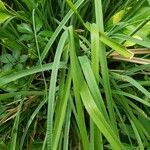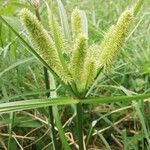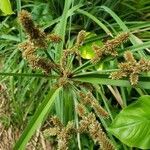Perennial with very short rhizome. Stems stout, tufted, trigonous, smooth, leafy at the much thickened base, up to 125 by 1 cm. Leaves flat or somewhat plicate with the midrib prominent beneath and 2 lateral nerves strongly marked above, coriaceous, scabrous on margins and nerves, 6-16 mm wide; lower sheaths spongy, cinnamomeous to fuscous. Inflorescence compound or decompound, up to 30 cm long. Involucral bracts 4-7, much overtopping the inflorescence, erecto-patent, up to 65 by 1 cm. Primary rays 5-10, unequal, smooth, suberect, rigid, up to 20 cm; secondary ones usually very short, up to 6 cm. Spikes digitately arranged, oblong-cylindrical to cylindrical, divergent, very dense, 2-4 cm by 8-15 mm; rachis hidden by the densely crowded spikelets. Spikelets spicately arranged, ultimately at right angles to the rachis, somewhat turgid, ovate to oblong-lanceolate, 12-30-flowered, 4-6(-8) by 2-2½ mm; rachilla straight, strongly compressed, persistent; internodes 1/5-¼ mm; wings very narrow, long-persistent, whitish. Glumes membranous, concave, not keeled, with finally inrolled margins, obliquely patent, finally wide-spreading, ovate or elliptic-ovate, obtuse, apiculate or minutely mucro-nulate, 5-7-nerved in the centre, yellowish or golden with purple stripes, 1½-2¼ by 1-1¼ mm, very densely (⅔-¾) imbricate. Stamens 2(-3); anthers linear-oblong, ½-1 mm long; connective shortly produced, smooth. Stigmas in most flowers 2, not rarely 3 in some flowers of the same inflorescence. Nut dorsoventrally compressed, planoconvex or (in the trigynous flowers) with a raised dorsal angle, elliptic to slightly obovate, shortly apiculate, golden yellow or stramineous, 0.8-0.9 by 0.5-0.6 mm.
More
Herbs, perennial, rhizomatous, coarse. Culms trigonous, 150–250 cm × 2–15 mm, glabrous. Leaves inversely W-shaped, 30–150 cm × 6–22 mm. Inflorescences: spikes 1–4, cylindric, 1.5–4 cm × 7–15 mm; rays 3–9, 10–26 cm; 2d order rays 2–11 cm; 3d order rays 1–4 cm (or absent); bracts 3–5, ± horizontal, 20–100 cm × 3–15 mm; 2d order bracts 2–7 cm × 2–7 mm; 3d order bracts 2–5 cm × 2–4 mm (or absent); rachilla persistent, wingless or wing hyaline, narrow, 0.1 mm wide. Spikelets 50–100, linear, ± quadrangular, slightly compressed, 8–11 × 0.9–1.2 mm; floral scales 15–30, marginally clear, laterally reddish along midrib, medially green, laterally 3–4 ribbed, medially 3–5-ribbed, ovate, 1–2–1.6 × 1.1–1.3 mm, apex mucronulate. Flowers: anthers 2, 0.4–0.5 mm; styles 0.8–1 mm; stigmas 2, 0.4 mm. Achenes dark brown, sessile, ellipsoid to obovoid, 0.9 × 0.4–0.5 mm, surfaces finely puncticulate.
Robust, perennial herb, up to 1.5 m high. Culms triangular. Basal leaves crowded. Inflorescence an umbel-like anthela, 100-300 mm long, 100-300 mm wide. Spikes 10-40 mm long. Glumes with margin in lower half inrolled to reveal nutlet, pale to golden brown.
Somewhat less robust than C. dives Del. and with the edges of the flattened achenes exposed in the ripe spikelet




